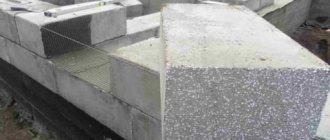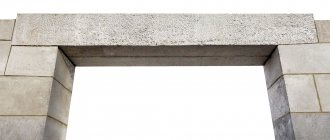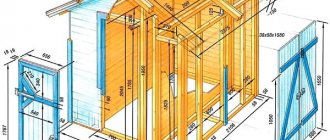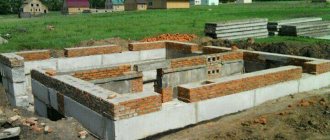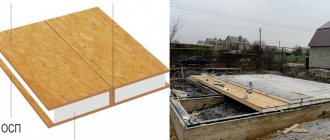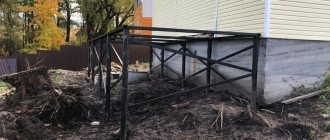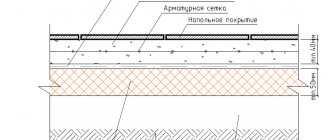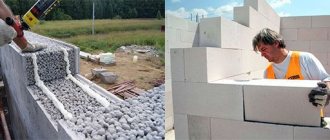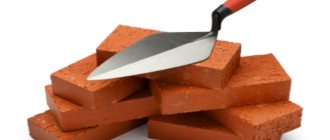General information
Expanded polystyrene concrete appeared as an attempt to make a building material that would not require additional external thermal insulation of walls. Polystyrene beads began to be added to the cement composition, providing the material with excellent thermal insulation qualities. Modern polystyrene boards contain water, sand, cement, polystyrene foam granules, air-entraining and plasticizing additives, and in some cases surfactants that increase the adhesion of foam balls and cement composition.
Taking into account the ratios in which the components for the slabs were used, the material can be used to construct partitions, load-bearing structures or as a thermal insulation layer. One slab can replace up to 25 bricks, which means the speed of building a house from polystyrene concrete blocks increases significantly.
Production of permanent formwork
Permanent formwork made of expanded polystyrene is intended for the rapid construction of monolithic buildings of various heights, both directly supporting structures and for filling openings in external walls in frame-braced buildings. This heat-saving technology for heat protection, sound insulation, comfort, simplicity, speed and cost of construction, strength and durability of buildings belongs to high technologies in the field of construction.
“Warm House” is one of the latest monolithic house-building technologies using permanent polystyrene foam blocks, which allows the construction of cottages, multi-storey buildings, and refrigerators.
The starting material for the production of permanent formwork is polystyrene. Polystyrene is an absolutely harmless, environmentally friendly material. The construction of walls using the “Warm House” technology consists of three stages: installation of a wall fragment from permanent formwork blocks on the existing foundation; laying of reinforcement; filling the internal cavity of polystyrene blocks with concrete.
The special design of the locks allows you to quickly and accurately connect blocks, similar to assembling cubes in the popular children's game "LEGO" and prevents concrete from leaking out.
The rigid frame-power structure of monolithic walls with low weight provides reliable anti-seismic properties to objects built using the “Warm House” technology.
The “Warm House” construction system ensures ease of laying and installation of sewer, water pipes and electrical wiring.
| Main wall block (BSO) Main wall block (BSO) is the first block that PKP Teply Dom CJSC used in its technology. It is very convenient and easy to build. From the block you can build angles at different degrees to form circular walls, pools, etc. |
| Prefabricated wall block (BSS) It consists of two polystyrene foam walls 5 cm thick, connected to each other by metal-plastic jumpers (MPP). |
| Prefabricated wall block with a thickened wall 75 mm It is used in northern regions with harsh climates, where additional thermal insulation of walls is required, as well as for the construction of refrigeration chambers and workshops. |
| Prefabricated wall block for internal partitions The advantage of this block is that by reducing the thickness of the wall, the consumption of concrete is reduced and the usable area is increased. |
| End cap End cap (ET) is used to form corners when using BSO and BSS with an outer wall thickness of 50 mm and an internal concrete cavity of 150 mm. |
Advantages and disadvantages
Features of the composition and method of manufacturing blocks allow us to see the numerous advantages of this material. The main advantages of polystyrene concrete are its following properties:
- Excellent sound insulation properties. A 25 cm wall blocks sound up to 70 dB.
- Good thermal insulation properties. According to the manufacturers, a wall 25 cm thick is sufficient to provide adequate heat transfer resistance in areas with a temperate climate. In areas with severe frosts, a wall 35 cm thick will be required.
- Increased resistance to moisture, resistance to rodents and fungi.
- The low weight of the slabs and their large dimensions make it possible to significantly facilitate and speed up construction using polystyrene concrete. There is no need to use complex heavy equipment. In addition, the slabs can be easily given the required shape, so they can be used to build a polystyrene concrete house even with complex structural elements.
- The building material has a flammability class of G1, that is, it is almost not flammable. Research has proven that after an hour of exposing a slab to a temperature of 1000 degrees, it remains intact. However, there is also a flip side to the coin. If a house made of polystyrene concrete panels survives a fire, then with a high degree of probability it will survive, but will be unsuitable for subsequent use, since the walls will lose the necessary strength.
- Increased frost resistance. The material can withstand more than 150 freeze/thaw cycles, which is 3 times more than foam concrete.
- Insignificant load on the foundation.
- Virtually no shrinkage.
- Low cost.
- Possibility to build a monolithic house from polystyrene concrete blocks without cold bridges.
- Excellent durability.
Since there is no such thing as an ideal building material, polystyrene concrete also has certain disadvantages. The main disadvantages are as follows:
- Difficulty organizing elements for fastening. Self-tapping screws and nails do not adhere well to a polystyrene concrete slab, so it is necessary to purchase anchor bolts that are designed for this material.
- Low vapor permeability will not allow excess moisture from the house to pass through the material, so you need to organize a good ventilation system, otherwise high humidity in the rooms cannot be avoided.
- With prolonged exposure to elevated temperatures, the foam balls burn out, leaving only a cement frame. However, high-quality plaster and finishing with non-combustible materials will help protect the walls.
- The quality of the slabs will largely depend on the strict adherence to the technological process. If the proportions of foam balls and cement are violated, the strength of the block is significantly reduced. When purchasing, always ask for a quality certificate.
- The walls definitely need to be plastered. The inner layer of plaster is at least 25 mm, the outer layer is at least 20 mm.
- The low density of the material complicates the installation of door and window openings. If you do not take into account the installation features, then after a few years you can end up with loose products.
Characteristics
Polystyrene concrete is a relatively new building material (it appeared on the construction market about ten years ago). New technologies make it possible to improve products made from this material, which expands the scope of application of polystyrene concrete mixtures. It is used to make blocks, slabs, etc. Polystyrene concrete blocks are rectangular in shape and impressive in size. These features simplify construction work. Plastic blocks have other characteristics, including:
frost resistance; low degree of thermal conductivity; reliability; environmental safety; sound insulation. Return to contents
Construction of monolithic houses
Polystyrene concrete, like expanded clay concrete, makes it possible to build monolithic houses. The composition of the building material is the same, but individual slabs are not made from it, but rather poured into formwork, creating load-bearing walls.
Advantages of this solution:
- high speed of construction;
- there are no cold bridges because there are no seams;
- increased strength;
- minimal shrinkage.
The main disadvantage is the complexity of construction. Since the walls need to be poured in one go, a large amount of concrete and special equipment are needed, so in this case you can’t do it yourself, but you can easily build a house out of slabs with your own hands.
Frost resistance, strength and density
GOST 51264–99 regulates the main performance qualities of polystyrene concrete. Taking into account this regulatory document, concrete grades D200-D600 are determined, where the digital designation corresponds to the density in kg/m3.
GOST also determines the level of compressive strength B1-B3: the higher the coefficient, the more significant the load the slab can withstand. In this case, compressive strength in some cases is designated using the letter M and a coefficient of 3−6. This marking is used for building materials manufactured without taking into account the standards of ST SEV 1406.
Frost resistance is determined by the cycles of freezing and thawing that the slab can withstand while maintaining all its positive properties. For polystyrene concrete, frost resistance is in the range of F30-F100 and increases with increasing density of the building material.
In terms of density, polystyrene concrete has 3 classes:
- Structural and thermal insulating polystyrene concrete with a density of D450-D650 is used for the construction of load-bearing walls of houses (up to 4 floors) and non-load-bearing walls in multi-storey buildings. Monolithic structures are also constructed from these types of concrete.
- Thermal insulating structural polystyrene concrete D300-D400 is used for thermal insulation of non-load-bearing walls. In certain situations, D400 slabs are used for the construction of external load-bearing walls, provided that the building has no more than 2 floors.
- Thermal insulating polystyrene concrete D100-D250 with a low coefficient of thermal conductivity and strength. It is used for insulating floors, external walls and heat-conducting structures.
Features of choice
Today, a large number of low-quality products have appeared on the market, this is due to the growing popularity of polystyrene concrete. Certain companies that previously produced foam blocks began to produce polystyrene concrete, and often attempts to quickly develop this market lead to a decrease in the quality of the material. What you need to pay attention to when purchasing polystyrene concrete:
- Same size foam balls.
- Uniform filling of the cement composition with granules.
- When ordering polystyrene concrete, you need to find out as much information as possible about the manufacturer, therefore you must boldly clarify where the production is located and find out the specifics of manufacturing the material. A normal manufacturer will be able to invite you to production and show the finished products, and will also advise what wall thickness is desirable, what density to choose for this, recommend how to secure various structures, what adhesives to use during installation - that is, they must give you an answer to any question .
- Correspondence between the mass of the slab and the specified density.
- The quality certificate is an important point. However, even its presence is not a guarantee of quality products. If you work with a distributor, and he provides you with a certificate from the manufacturer, then it is better to verify directly with the manufacturer that he works with this seller.
Negative and positive aspects of using materials
Polystyrene concrete blocks have their pros and cons. Let's list the main advantages: reduction in material costs that would be required for additional insulation and heating of premises, variety of construction work (blocks can be given different shapes), fire and frost resistance, durability, sound insulation. To build a house, you do not need to use special equipment: the weight and size of the blocks allow you to do without it. In addition, polystyrene concrete is environmentally safe. The material does not rot because microorganisms do not grow in it.
However, the building material has its disadvantages, despite its advantages. Experienced builders note disadvantages that often appear due to improper manufacturing of blocks. Although polystyrene concrete structures are difficult to burn, fire can affect their strength. A house made of blocks is prone to microcracks and shrinkage. To avoid this, special fibers are added to the solution. This must be taken into account when making materials with your own hands. Experts also point out other disadvantages, in particular, low-quality filler or its lack leads to a decrease in the properties of plastic blocks. Therefore, the manufacture of products requires strict adherence to the rules and proportions for mixing the solution. There are also less significant disadvantages of building materials: a house made of polystyrene concrete requires plaster, which increases the cost of finishing the building. Additional disadvantages are also known: the products have poor adhesion to the plaster solution. It is necessary to prepare polystyrene concrete blocks before covering the surface.
Currently reading: Do-it-yourself deep concrete vibrator based on a drill and a hammer drill
Return to contents
DIY making
You can make polystyrene concrete slabs yourself. The more carefully the master adheres to the technology, the more reliable the resulting blocks will be. The required set of basic components is simple. You will need sand, concrete, water and foam balls. Instead of cement, in some cases a gypsum composition is chosen as the basis. Various modifying substances can be added to the solution, for example, an air-entraining additive.
The ratios of substances will depend on what kind of slab you need to get and what you need to focus on, increased strength or thermal insulation. The larger the portion of concrete, the higher the strength of the resulting product.
For structural thermal insulation boards, you can use the following proportions: three buckets of sand, a bucket of cement, 12 liters of water, 7-9 buckets of foam balls. The manufacturing sequence is as follows:
- Pour water into the concrete mixer, add all the additives and half the total volume of granules so that the concrete does not stick to the walls so much. Water can then be added to achieve the desired consistency.
- Concrete is poured, the composition is stirred to a homogeneous consistency.
- Sand and the remaining foam balls are poured in, everything is thoroughly mixed, the required consistency of the composition should be a little dry, this makes it more convenient to work with the forms.
- The composition is poured into molds. For this, you can use a welded metal box you made yourself. You can make a matrix from boards, but you need to treat the mold with machine oil. The mixture is thoroughly compacted on top; vibration can be used for about five seconds, but not longer - prolonged vibration violates the strength of the slabs.
- The slabs are taken out and allowed to dry for 24 hours in a warm place, with a temperature of more than +15 degrees; you can cover them with polyethylene. The blocks gain full strength for construction within one month.
Manufacturing
Making polystyrene concrete at home is an essential part of building a house yourself. There are several types of polystyrene concrete, which differ from each other in density. Depending on the labeling, a particular name can be used for various purposes. Let's look at the most common markings of polystyrene concrete that are used in modern construction.
| Product labeling | Cement grade M400, kg. | Modifying additive PB 2000, l. | Water, l. | Polystyrene, kb/m |
| D 200 | 200 | 0.2 – 03l | 80 | 1,0 |
| D 300 | 300 | similarly | 100 | similarly |
| D 400 | 350 | 0,1 – 0,2 | 150 | similarly |
| D 500 | 420 | similarly | 180 | similarly |
| D 600 | 500 | 0,1 | 200 | similarly |
Note! In some cases, it may be necessary to add a mineral filler (sand) - in this case its share with cement is 1:1. This significantly increases the strength characteristics of the product, but at the same time increases weight and worsens thermal conductivity. This action must be due to structural reasons.
Liquid polystyrene concrete
Products of the D200 – D 300 brand are used to create an insulating layer. Polystyrene concrete D 400 and D 500 can be used for the construction of intermediate or load-bearing walls in small-sized construction (temporary buildings, garages, etc.). Brand names D 600 can be used in private low-rise construction.
Mixing polystyrene concrete is best done using a concrete mixer or a closed bucket. The presence of PB 2000 additives is mandatory, since in addition to air-entraining properties, it also plays the role of a surfactant, increasing the degree of adhesion of filler granules to cement mortar.
Construction from polystyrene concrete
Building a home is a complex, multi-step process that will require basic construction skills. Briefly, building a house looks like this:
- Foundation construction. Since the total mass of the structure is small, you can choose a pile, strip or column foundation.
- Creation of walls using the selected technology: from slabs, with permanent or removable formwork. In this case, construction should begin with the installation of a waterproofing layer and determining the highest place from which the walls will be laid. During laying, you must maintain horizontal and vertical levels. To increase strength, reinforcement is laid horizontally. If blocks with voids are used, then vertical reinforcement is performed. The thickness of the adhesive seam is no more than 10 mm. Monolithic walls are constructed using removable plywood formwork 20 mm thick, and it must be protected with polyethylene from moisture. The plywood is held in place by installing metal profiles that are secured to the foundation. Plywood sheets are attached to the profiles, first the external partitions are made, then the internal ones. The concrete mixture is carefully compacted during pouring, and the formwork is removed after 3-4 days.
- The ceiling can be made from special polystyrene concrete slabs or also using pouring. Floor screed is made using classical methods.
- A building made of polystyrene concrete requires external finishing. You can choose plaster, siding, artificial stone. Inside, you first need to make a layer of plaster, then putty, after that you can choose from: decorative plaster, painting the walls, wallpapering.
You can build a house made of polystyrene concrete with your own hands in a few months, and this building will stand, of course, taking into account all the features of the technology, for decades. Most importantly, do not forget about special fasteners and a high-quality ventilation system.
